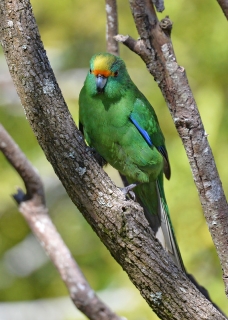Orange-fronted Parakeet |
|
|
Also known as: Malherbe's Parakeet, Orange-fronted Kakariki
Species Profile
Genus: Cyanoramphus | Species: malherbi
Size:
20cm (7.8 in)
Weight:
Male: 45-55g Female: 38-50g
Subspecies including nominate:
one
Colour Adult:
Both adults: mainly bright green body; orange frontal band from eye to eye; lemon/yellow crown; orange patch on each side of rump; outer webs of flight feathers purple/blue. Bill blue/grey tipped with black, with black cutting edge. Eye red.
Colour Juvenile:
As in adults but with frontal band lighter and more indistinct; lemon yellow crown is less extensive and paler; shorter tail for several weeks after fledging. Bill pale pink colour which gradually darkens. Darker red/brown eyes.
Call:
As in Yellow-fronted Parakeet (Cyanoramphus auriceps). a repetitive note ki-ki-ki-ki, often slightly higher in pitch and more rapid than in Yellow-crowned Parakeet.
Listen NowVideo Links:
Video 1 | Video 2 | Video 3More Information:
Team OFP: Save NZ's Orange-fronted Parakeet
Content Sources:
CITES
BirdLife International
Cornell Lab of Ornithology/Birds of the World
Parrots: A Guide to Parrots of the World, Juniper and Parr, 1998
Jack van Hal, Canterbury Conservancy, New Zealand Dept. of Conservation, pers. comm.
Parrots: Status Survey and Conservation Plan 2000-2004, Snyder, McGowan, Gilardi and Grajal, 2000.
Parrots of the World, Forshaw and Cooper, 1977. 2010 edition
Vanished and Vanishing Parrots, Forshaw, 2017.
Lexicon of Parrots, Thomas Arndt.
Parrots of the World, Forshaw, 2006.
Parrots: Their Care and Breeding, Low, 1986.
Parrots in Aviculture, Low, 1992.
Species Care
Captive Status:
Not usually found in captivity as pets. Small captive breeding programme established in 2003.
Longevity:
Not recorded.
Housing:
3.5 x 1 x 2m (11.5 x 3.3 x 6.5 ft) enclosure.
Diet:
Small seeds such as: canary, millet and smaller amounts of oats, buckwheat and safflower; limited sunflower seed; spray millet; green leaves such as: Swiss chard, lettuce, sowthistle, dandelion, chickweed; seeding grasses if available; rearing food made with: hard-boiled egg, wholemeal bread and carrot, all ground up; fruits such as: apple, pear, banana, pomegranate; mealworms or other insectivore diet; complete pellet or multivitamin.
Enrichment:
Not recorded.
Nest Box Size:
8" x 8" x 14" (20.3cm x 20.3cm x 35.6cm) vertical box.
Clutch Size:
5-10
Incubation Time:
21 days
Fledging Age:
5-6 weeks
Hatch Weight:
Not recorded.
Peak Weight:
Not recorded.
Weaning Weight:
Not recorded.
Species Wild Status
World Population:
Fewer than 300.
IUCN Red List Status:
Critically Endangered
CITES Listing:
Appendix II
Threat Summary:
This species has suffered from feral rat and stoat introductions, and also loss of nesting beech trees through harvest and burning. Loss of low-lying brush to deer, cattle and possums. Psittacine beak and feather disease may be a threat.
Range:
New Zealand, formerly throughout North and South Islands, now only on South Island in South Hurunui, Poulter and Hawdon River valleys. Captive bred birds introduced to Chalky Island, Fiordland, and Maud and Blumine Islands. Also introduced in the north to Mayor Island.
Habitat:
Found below 1000m (3280 ft) in upland beech (Nothofagus) forests on the mainland; occurs in mixed Podocarp and beech areas on the two offshore islands at lower altitude.
Wild Diet:
Eats shoots, buds, berries, flowers, seeds and insects, including caterpillars, aphids and scale insects.
Ecology and Behaviour:
Seen in pairs or small flocks. Will flock with Yellow-crowned Parakeets (Cyanoramphus auriceps). Nests in holes in branch or trunk of mature beech tree. Feeding occurs during daylight hours, along with comfort behaviours.
Clutch and Egg Size:
5-11 broadly elliptical eggs, 22.6 x 18.8mm (0.9 x 0.7 in).
Breeding Season:
October. Nest is in tree hollow.
Related Links:
Research: The Orange-fronted Parakeet is a distinct species: a review...
Scientific American: Critically endangered parakeet population grows on predator-free island reserve
Members Only Resources
Please log-in now to find more research, resources and tools.
Not a Member?
Find more great information:
Gain exclusive access to 600+ pages of additional research, seminars and podcasts, specialists to ask your toughest questions, and dozens of other fun resources - when you become a WPT member.
Join Today >>

































